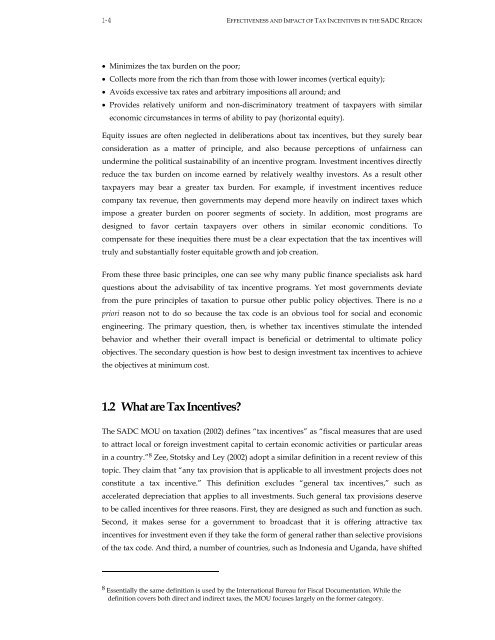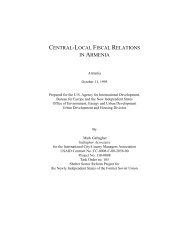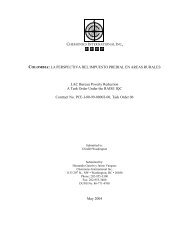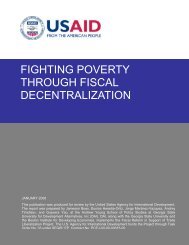Effectiveness and Economic Impact of Tax Incentives in the SADC ...
Effectiveness and Economic Impact of Tax Incentives in the SADC ...
Effectiveness and Economic Impact of Tax Incentives in the SADC ...
Create successful ePaper yourself
Turn your PDF publications into a flip-book with our unique Google optimized e-Paper software.
1-4 EFFECTIVENESS AND IMPACT OF TAX INCENTIVES IN THE <strong>SADC</strong> REGION<br />
• M<strong>in</strong>imizes <strong>the</strong> tax burden on <strong>the</strong> poor;<br />
• Collects more from <strong>the</strong> rich than from those with lower <strong>in</strong>comes (vertical equity);<br />
• Avoids excessive tax rates <strong>and</strong> arbitrary impositions all around; <strong>and</strong><br />
•<br />
Provides relatively uniform <strong>and</strong> non-discrim<strong>in</strong>atory treatment <strong>of</strong> taxpayers with similar<br />
economic circumstances <strong>in</strong> terms <strong>of</strong> ability to pay (horizontal equity).<br />
Equity issues are <strong>of</strong>ten neglected <strong>in</strong> deliberations about tax <strong>in</strong>centives, but <strong>the</strong>y surely bear<br />
consideration as a matter <strong>of</strong> pr<strong>in</strong>ciple, <strong>and</strong> also because perceptions <strong>of</strong> unfairness can<br />
underm<strong>in</strong>e <strong>the</strong> political susta<strong>in</strong>ability <strong>of</strong> an <strong>in</strong>centive program. Investment <strong>in</strong>centives directly<br />
reduce <strong>the</strong> tax burden on <strong>in</strong>come earned by relatively wealthy <strong>in</strong>vestors. As a result o<strong>the</strong>r<br />
taxpayers may bear a greater tax burden. For example, if <strong>in</strong>vestment <strong>in</strong>centives reduce<br />
company tax revenue, <strong>the</strong>n governments may depend more heavily on <strong>in</strong>direct taxes which<br />
impose a greater burden on poorer segments <strong>of</strong> society. In addition, most programs are<br />
designed to favor certa<strong>in</strong> taxpayers over o<strong>the</strong>rs <strong>in</strong> similar economic conditions. To<br />
compensate for <strong>the</strong>se <strong>in</strong>equities <strong>the</strong>re must be a clear expectation that <strong>the</strong> tax <strong>in</strong>centives will<br />
truly <strong>and</strong> substantially foster equitable growth <strong>and</strong> job creation.<br />
From <strong>the</strong>se three basic pr<strong>in</strong>ciples, one can see why many public f<strong>in</strong>ance specialists ask hard<br />
questions about <strong>the</strong> advisability <strong>of</strong> tax <strong>in</strong>centive programs. Yet most governments deviate<br />
from <strong>the</strong> pure pr<strong>in</strong>ciples <strong>of</strong> taxation to pursue o<strong>the</strong>r public policy objectives. There is no a<br />
priori reason not to do so because <strong>the</strong> tax code is an obvious tool for social <strong>and</strong> economic<br />
eng<strong>in</strong>eer<strong>in</strong>g. The primary question, <strong>the</strong>n, is whe<strong>the</strong>r tax <strong>in</strong>centives stimulate <strong>the</strong> <strong>in</strong>tended<br />
behavior <strong>and</strong> whe<strong>the</strong>r <strong>the</strong>ir overall impact is beneficial or detrimental to ultimate policy<br />
objectives. The secondary question is how best to design <strong>in</strong>vestment tax <strong>in</strong>centives to achieve<br />
<strong>the</strong> objectives at m<strong>in</strong>imum cost.<br />
1.2 What are <strong>Tax</strong> <strong>Incentives</strong>?<br />
The <strong>SADC</strong> MOU on taxation (2002) def<strong>in</strong>es “tax <strong>in</strong>centives” as “fiscal measures that are used<br />
to attract local or foreign <strong>in</strong>vestment capital to certa<strong>in</strong> economic activities or particular areas<br />
<strong>in</strong> a country.” 8 Zee, Stotsky <strong>and</strong> Ley (2002) adopt a similar def<strong>in</strong>ition <strong>in</strong> a recent review <strong>of</strong> this<br />
topic. They claim that “any tax provision that is applicable to all <strong>in</strong>vestment projects does not<br />
constitute a tax <strong>in</strong>centive.” This def<strong>in</strong>ition excludes “general tax <strong>in</strong>centives,” such as<br />
accelerated depreciation that applies to all <strong>in</strong>vestments. Such general tax provisions deserve<br />
to be called <strong>in</strong>centives for three reasons. First, <strong>the</strong>y are designed as such <strong>and</strong> function as such.<br />
Second, it makes sense for a government to broadcast that it is <strong>of</strong>fer<strong>in</strong>g attractive tax<br />
<strong>in</strong>centives for <strong>in</strong>vestment even if <strong>the</strong>y take <strong>the</strong> form <strong>of</strong> general ra<strong>the</strong>r than selective provisions<br />
<strong>of</strong> <strong>the</strong> tax code. And third, a number <strong>of</strong> countries, such as Indonesia <strong>and</strong> Ug<strong>and</strong>a, have shifted<br />
8 Essentially <strong>the</strong> same def<strong>in</strong>ition is used by <strong>the</strong> International Bureau for Fiscal Documentation. While <strong>the</strong><br />
def<strong>in</strong>ition covers both direct <strong>and</strong> <strong>in</strong>direct taxes, <strong>the</strong> MOU focuses largely on <strong>the</strong> former category.











